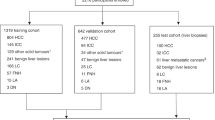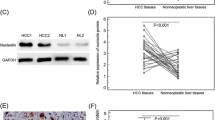Abstract
Purpose
To investigate the sensitivity, specificity, and spatial distribution of the product of p28 gene (p28GANK protein) in human hepatocellular carcinoma (HCC) and nonhepatocellular carcinomas in relation to immunostaining with Cytokeratin 18 (CK18), α-fetoprotein (AFP), and Hepatocyte paraffin 1 (HepPar1).
Method
In this retrospective study, formalin-fixed paraffin-embedded tissues from 24 HCCs, five intrahepatic cholangiocarcinomas (ICC), five combined hepatocellular cholangiocarcinomas (C-HCC-CC) and mine metastatic hepatic carcinomas (MHC) were immunostained for p28GANK as well as CK18, AFP and HepPar1. Only cases with more intensified staining in carcinoma contrast to the adjacent liver tissues were accepted as positive.
Result
In HCC, p28GANK was expressed restrictively in hepatocytes of both para-lesion and carcinoma liver tissues, while absent in the bile duct epithelial cells, Kupffer cells, and other interstitial cells. The positive staining of p28GANK was noted in 16 (66.7%) specimens of HCC and three (60.0%) specimens of C-HCC-CC, and no specific lesion staining was found in all tested specimens of ICC and MHC. Sensitivity and specificity for hepatocyte-originated carcinoma were, respectively, 65.5% and 100% for p28GANK, 79.3% and 85.2% for CK18, 20.7% and 100% for AFP, 79.3% and 92.0% for HepPar1.
Conclusion
The hepatocytic staining for p28GANK is clearly useful in differentiating hepatocyte-originated carcinoma from non-HCC. p28GANK may be used as an ancillary marker for the diagnosis of HCC.



Similar content being viewed by others
Abbreviations
- HCC:
-
Hepatocellular carcinoma
- ICC:
-
Intrahepatic cholangiocarcinoma
- C-HCC-CC:
-
Combined hepatocellular cholangiocarcinoma
- MHC:
-
Metastatic hepatic carcinoma
- HepPar1:
-
Hepatocyte paraffin 1
- CK18:
-
Cytokeratin 18
- AFP:
-
α-fetoprotein
- IHC:
-
Immunohistochemistry
References
Baumeister W, Walz J, Zuhl F, Seemuller E (1998) The proteasome: paradigm of a self-compartmentalizing protease. Cell 92:367–380
Chen CJ, Yu MW, Liaw YF (1997) Epidemiological characteristics and risk factors of hepatocellular carcinoma. J Gastroenterol Hepatol 12:S294–308
Christensen WN, Boitnott JK, Kuhajda FP (1989) Immunoperoxidase staining as a diagnostic aid for hepatocellular carcinoma. Mod Pathol 2:8–12
Chu PG, Ishizawa S, Wu E, Weiss LM (2002) Hepatocyte antigen as a marker of hepatocellular carcinoma: an immunohistochemical comparison to carcinoembryonic antigen, CD10, and alpha-fetoprotein. Am J Surg Pathol 26:978–988
D’Errico A, Baccarini P, Fiorentino M, et al (1996) Histogenesis of primary liver carcinomas: strengths and weaknesses of cytokeratin profile and albumin mRNA detection. Hum Pathol 27:599–604
Edmundson HA, Steiner PE (1954) Primary carcinoma of the liver. A study of 100 cases among 48,900 necropsies. Cancer 7:462–503
Fu XY, Wang HY, Tan L, et al (2002) Overexpression of p28/gankyrin in human hepatocellular carcinoma and its clinical significance. World J Gastroenterol 8:638–643
Ganjei P, Nadji M, Albores-Saavedra J, et al (1988) Histologic markers in primary and metastatic tumors of the liver. Cancer 62:1994–1998
Higashitsuji H, Itoh K, Nagao T, et al (2000) Reduced stability of retinoblastoma protein by gankyrin, an oncogenic ankyrin-repeat protein overexpressed in hepatomas. Nature Med 6:96–99
Hori T, Kato S, Saeki M, et al (1998) cDNA cloning and functional analysis of p28(Nas6p) and p40.5(Nas7p), two novel regulatory subunits of the 26S proteasome. Gene 216:113–122
Hurlimann J, Gardiol D (1991) Immunohistochemistry in the differential diagnosis of liver carcinomas. Am J Surg Pathol 15:280–288
Kumagai I, Masuda T, Sato S, Ishikawa K (2001) Immunoreactivity to monoclonal antibody, Hep Par 1, in human hepatocellular carcinomas according to histopathological grade and histological pattern. Hepatol Res 20:312–319
Lau SK, Prakash S, Geller SA, Alsabeh R (2002) Comparative immunohistochemical profile of hepatocellular carcinoma, cholangiocarcinoma, and metastatic adenocarcinoma. Hum Pathol 33:1175–1181
Leong AS, Sormunen RT, Tsui WM, Liew CT (1998) Hep Par 1 and selected antibodies in the immunohistological distinction of hepatocellular carcinoma from cholangiocarcinoma, combined tumours and metastatic carcinoma. Histopathology 33:318–324
Li J, Tsai MD (2002) Novel insights into the INK4-CDK4/6-Rb pathway: counter action of gankyrin against INK4 proteins regulates the CDK4-mediated phosphorylation of Rb. Biochemistry 41:3977–3983
Ma CK, Zarbo RJ, Frierson HF Jr, et al (1993) Comparative immunohistochemical study of primary and metastatic carcinomas of the liver. Am J Clin Pathol 99:551–557
Maeda T, Kajiyama K, Adachi E, et al (1996) The expression of cytokeratins 7, 19, and 20 in primary and metastatic carcinomas of the liver. Mod Pathol 9:901–909
Minervini MI, Demetris AJ, Lee RG, et al (1997) Utilization of hepatocyte-specific antibody in the immunocytochemical evaluation of liver tumors. Mod Pathol 10:686–692
Morrison C, Marsh W Jr, Frankel WL (2002) A comparison of CD10 to pCEA, MOC-31, and hepatocyte for the distinction of malignant tumors in the liver. Mod Pathol 15:1279–1287
Ogawa A, Kanda T, Sugihara S et al (1996) Correlation between serum level of, and tissue positivity for, alpha-fetoprotein in hepatocellular carcinoma. J Med 27:33–40
Park TJ, Kim HS, Byun KH, Jang JJ, Lee YS, Lim IK (2001) Sequential changes in hepatocarcinogenesis induced by diethylnitrosamine plus thioacetamide in Fischer 344 rats: induction of gankyrin expression in liver fibrosis, pRB degradation in cirrhosis, and methylation of p16(INK4A) exon 1 in hepatocellular carcinoma. Mol Carcinog 30:138–150
Qin JM, Fu XY, Li SJ, et al (2003) Gene and protein expressions of p28GANK in rat with liver regeneration. World J Gastroenterol 9:2523–2527
Rishi M, Kovatich A, Ehya H (1994) Utility of polyclonal and monoclonal antibodies against carcinoembryonic antigen in hepatic fine-needle aspirates. Diagn Cytopathol 11:358–361
Sato K, Tanaka M, Kusaba T, et al (1998) Immunohistochemical demonstration of alpha-fetoprotein in small hepatocellular carcinoma. Oncol Rep 5:355–358
Sithinamsuwan P, Piratvisuth T, Tanomkiat W, et al (2000) Review of 336 patients with hepatocellular carcinoma at Songklanagarind Hospital. World J Gastroenterol 6:339–343
Sylla A, Diallo MS, Castegnaro J, Wild CP (1999) Interactions between hepatitis B virus infection and exposure to aflatoxins in the development of hepatocellular carcinoma: a molecular epidemiological approach. Mutat Res 428:187–196
Tang ZY (2000) Hepatocellular carcinoma. J Gastroenterol Hepatol 15 [Suppl]:G1–7
Tsuji M, Kashihara T, Terada N, Mori H (1999) An immunohistochemical study of hepatic atypical adenomatous hyperplasia, hepatocellular carcinoma, and cholangiocarcinoma with alpha-fetoprotein, carcinoembryonic antigen, CA19–9, epithelial membrane antigen, and cytokeratins 18 and 19. Pathol Int 49:310–317
Wee A, Nilsson B (1997) pCEA canalicular immunostaining in fine needle aspiration biopsy diagnosis of hepatocellular carcinoma. Acta Cytol 41:1147–1155
Yao JL (1996) Perinatal transmission of hepatitis B virus infection and vaccination in China. Gut 38 [Suppl 2]:S37–38
Acknowledgments
The authors thank Dr. Wenming Cong and Dr. Shuhui Zhang for their excellent evaluation of the antibody, also thank Liang Tang, Weiqing Wu, Ling Huang, and Xiuzhong Zhang for their helpful technical assistance.
Author information
Authors and Affiliations
Corresponding author
Additional information
This work was supported by the Chinese National Key Project of Basic Research (No. 001CB510205), the Hi-Tech Research and Development Program of China (No. 2002BA711A02-3), and the Shanghai Science and Technology Committee Grant (No. 03DJ14007).
Rights and permissions
About this article
Cite this article
Fu, X., Tan, L., Liu, S. et al. A novel diagnostic marker, p28GANK distinguishes hepatocellular carcinoma from potential mimics. J Cancer Res Clin Oncol 130, 514–520 (2004). https://doi.org/10.1007/s00432-004-0562-y
Received:
Accepted:
Published:
Issue Date:
DOI: https://doi.org/10.1007/s00432-004-0562-y




